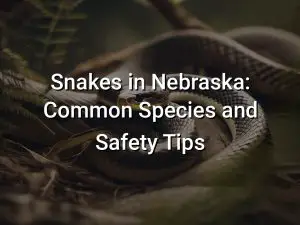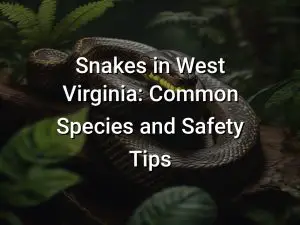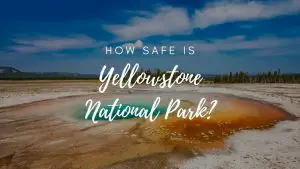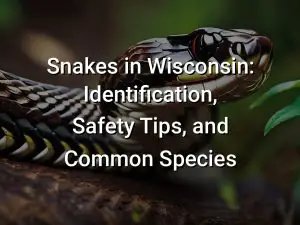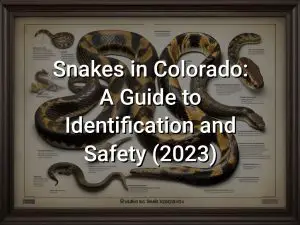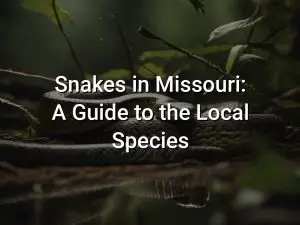Snakes in Montana: Common Species and Safety Tips
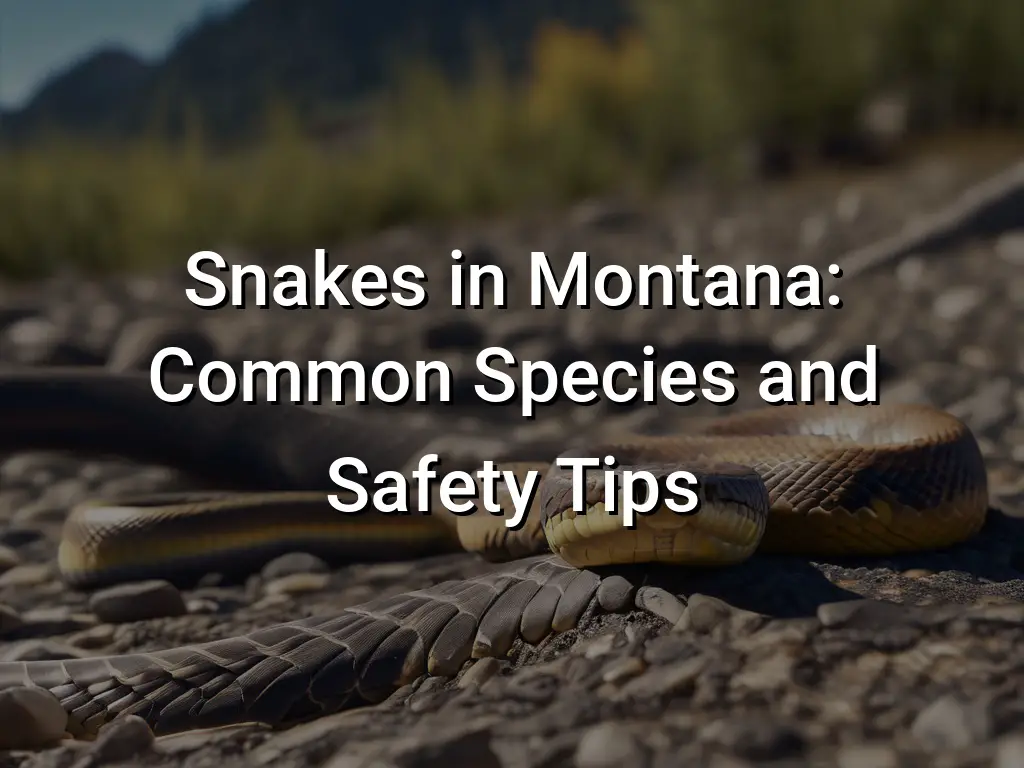
Montana, the Treasure State, is known for its stunning landscapes and abundant wildlife. While the state is home to various types of wildlife, including snakes, it’s important to have an understanding of the common snake species found in Montana and how to stay safe when encountering them.
In this article, we’ll explore the different types of snakes found in Montana, including rattlesnakes, garter snakes, bullsnakes, and rubber boas. We’ll also provide safety tips for identifying dangerous snakes, snake bite first aid, preventing snake encounters, and snake removal and relocation methods. So whether you’re a Montana resident or planning a visit, read on to learn more about the fascinating snakes in Montana and how to coexist with them safely.
Quick Links
Types of Snakes in Montana
Montana is home to a variety of snake species, each with its own unique characteristics and behaviors. While most snakes in Montana are harmless, there are a few venomous species that require caution. Here are some of the common types of snakes you may encounter in Montana:
- Rattlesnakes: Rattlesnakes are the only venomous snakes in Montana. They have a distinct rattle on their tail, which they use as a warning when agitated. There are three species of rattlesnakes found in Montana: the Western Rattlesnake, the Prairie Rattlesnake, and the Midget Faded Rattlesnake.
- Garter Snakes: Garter snakes are one of the most common snakes found in Montana. They are non-venomous and are often seen near bodies of water, such as ponds and streams. Garter snakes are known for their vibrant colors and can vary in pattern and appearance.
- Bullsnakes: Bullsnakes are large and powerful snakes that are often mistaken for rattlesnakes due to their similar appearance and defensive behavior. However, bullsnakes are non-venomous and play an important role in controlling rodent populations.
- Rubber Boas: Rubber boas are small, stout-bodied snakes that have a unique appearance and behavior. They are typically brown or tan in color and have a blunt tail. Rubber boas are non-venomous and feed primarily on small mammals.
It’s important to note that snakes play a valuable role in Montana’s ecosystem and should be respected and observed from a safe distance. It’s best to leave snakes alone and avoid provoking them, especially venomous species like rattlesnakes. If you encounter a snake, it’s recommended to back away slowly and give the snake space to retreat.
Rattlesnakes
Rattlesnakes are one of the most well-known and potentially dangerous snake species in Montana. They are venomous snakes characterized by their distinctive rattling tail, which they use as a warning to potential threats.
In Montana, the most common species of rattlesnakes include the Western Rattlesnake and the Prairie Rattlesnake. Both species are found in various habitats, including grasslands, forests, and rocky areas.
Rattlesnakes are ambush predators and rely on their camouflage to blend in with their surroundings. They wait patiently for small mammals, birds, or reptiles to come by before striking and injecting venom into their prey.
If you encounter a rattlesnake in Montana, it’s important to give it a wide berth and avoid provoking or agitating it. Rattlesnakes prefer to avoid confrontation and will usually only bite if they feel threatened or cornered.
If you hear the distinctive rattle of a rattlesnake, immediately stop and try to locate the snake. Slowly and calmly back away from the snake, giving it space to retreat. Do not attempt to handle or capture a rattlesnake, as this greatly increases the risk of being bitten.
If you or someone you know is bitten by a rattlesnake, seek medical attention immediately. Try to remember the snake’s appearance to help healthcare professionals identify the species and administer appropriate treatment.
It’s important to respect and appreciate the role rattlesnakes play in the ecosystem. They help control rodent populations and are an integral part of Montana’s wildlife. By understanding their behavior and taking necessary precautions, you can safely coexist with rattlesnakes in their natural habitat.
Garter Snakes
Garter snakes are one of the most common snake species found in Montana. They are non-venomous snakes that are typically small to medium in size, ranging from about one to four feet in length. Garter snakes are known for their distinct appearance, with a long and slender body that is usually brown or black in color and adorned with stripes or patterns along their back and sides.
These snakes are highly adaptable and can be found in a variety of habitats, including grasslands, forests, wetlands, and even urban areas. They are often seen near bodies of water, such as lakes, ponds, and rivers, as they are excellent swimmers and feed on aquatic prey.
Garter snakes are primarily carnivorous and feed on a diet consisting of small vertebrates, such as frogs, toads, fish, and small mammals. They are also known to consume invertebrates, including insects, worms, and slugs. Garter snakes are not a threat to humans and are generally docile in nature. If encountered, they will usually try to escape rather than engage in aggressive behavior.
It is important to note that although garter snakes are harmless, they may release a foul-smelling musk when threatened as a defense mechanism. This odor is meant to deter predators and is not harmful to humans, but it can be unpleasant.
If you come across a garter snake in Montana, it is best to admire it from a distance and avoid disturbing or attempting to handle it. Like all wildlife, garter snakes play an important role in the ecosystem and should be respected and appreciated for their contributions.
Bullsnakes
Bullsnakes, also known as gopher snakes, are a common species of nonvenomous snake found in Montana. They are the largest snake species in the state, with adults reaching lengths of 4 to 6 feet.
Bullsnakes have a distinctive appearance, with a light tan or yellow coloration and dark brown blotches along their body. Their scales are smooth and shiny, and they have a pointed head and round pupils.
These snakes are often found in grasslands, prairies, and open woodlands, where they feed on rodents, birds, and other small animals. They are constrictors, meaning they wrap their bodies around their prey and squeeze until the animal suffocates.
Bullsnakes are generally nonaggressive and will try to avoid humans if possible. However, they may hiss and strike if they feel threatened. It is important to remember that bullsnakes are nonvenomous and pose no significant danger to humans.
If you encounter a bullsnake in the wild, it is best to leave it alone and give it space to retreat. Like all snakes, bullsnakes play an important role in the ecosystem by controlling rodent populations.
If you have a bullsnake living on your property and would like to remove it, it is recommended to contact a professional snake removal service. They will safely and humanely relocate the snake to a more suitable habitat.
Rubber Boas
Rubber boas (Charina bottae) are a small and non-venomous species of snake that are commonly found in Montana. They are known for their unique appearance and behavior.
Physical Characteristics: Rubber boas are usually brown or tan in color, with smooth, shiny scales. They have a cylindrical body shape and a blunt head. One of their most distinctive features is their prehensile or gripping tail, which they use to hold onto objects.
Habitat and Range: Rubber boas can be found in a variety of habitats, including grasslands, forests, and rocky areas. They are most commonly found in western Montana, but their range extends to other parts of the state as well.
Behavior and Diet: Rubber boas are primarily nocturnal and are known for their ability to burrow and hide. They are excellent climbers and are often found in trees or under rocks and logs. They mainly feed on small mammals, such as mice and voles, as well as lizards and other snakes.
Reproduction: Rubber boas are ovoviviparous, meaning their eggs develop inside the female’s body and give birth to live young. They typically give birth to 2-3 young snakes at a time.
Conservation Status: Rubber boas are not considered a threatened species and are relatively common in their range. However, they may face habitat loss and fragmentation due to human development.
If you encounter a rubber boa in Montana, it is important to remember that they are harmless and play a beneficial role in the ecosystem by controlling rodent populations. It is best to observe them from a distance and avoid handling them unless necessary.
Safety Tips for Dealing with Snakes
Encountering snakes can be intimidating, but with the right knowledge and precautions, you can ensure your safety. Here are some important safety tips to keep in mind when dealing with snakes:
- Always give snakes their space. Most snake bites occur when people try to handle or kill snakes.
- Learn to identify the common snake species in your area. This will help you understand which snakes are venomous and which are harmless.
- If you encounter a snake, remain calm and slowly back away from it. Avoid making sudden movements or loud noises that may startle the snake.
- Avoid placing your hands or feet in areas where snakes may be hiding, such as under rocks, logs, or thick vegetation.
- When hiking or walking in snake-prone areas, wear sturdy, closed-toe shoes and long pants to protect yourself from potential bites.
- When camping, keep your tent zipped up at all times to prevent snakes from entering.
- Do not leave food or garbage exposed, as it may attract snakes and other wildlife.
- If you have a snake on your property that is causing concern, contact a professional snake removal service to safely remove and relocate the snake.
- In the event of a snake bite, seek medical attention immediately. Do not try to handle or capture the snake for identification purposes, as this can waste valuable time.
By following these safety tips, you can minimize the risk of encountering snakes and ensure your safety in snake-prone areas.
Identifying Dangerous Snakes
When spending time outdoors in Montana, it’s important to be able to recognize the different types of snakes you may come across and know which ones are potentially dangerous. While most snakes in Montana are harmless and play an important role in the ecosystem, there are a few venomous species to be aware of:
- Rattlesnakes: These venomous snakes have a distinctive rattle on their tail, which they use as a warning sign when they feel threatened. They have triangular-shaped heads and their coloration can vary, but they often have a pattern of dark patches or bands on a lighter background.
- Prairie Rattlesnakes: These are the most commonly encountered rattlesnakes in Montana. They have a light gray or brown coloration with dark blotches running down their bodies.
- Western Rattlesnakes: Western rattlesnakes are less common in Montana but can still be found in certain areas. They have a gray or brown coloration with dark blotches and a distinct diamond-shaped pattern on their back.
It’s important to note that not all snakes with rattles are venomous. Some non-venomous snakes may also produce a rattling sound by shaking their tails on dry leaves or grass to mimic the sound of a rattlesnake. Therefore, it’s best to give any snake displaying a rattling behavior a wide berth.
If you come across a snake and are unsure of its species or if it is venomous, it’s always best to err on the side of caution. Keep a safe distance and avoid any unnecessary contact with the snake.
Snake Bite First Aid
If you or someone you know is bitten by a snake, it’s important to take immediate action. Here are some first aid steps to follow:
- Stay calm and call for medical help. It’s important to seek professional medical attention as soon as possible, even if you don’t think the snake is venomous.
- Keep the bitten area immobilized. Avoid moving the affected limb or body part to prevent the venom from spreading more quickly.
- Remove any constrictive clothing or jewelry near the bite site. Swelling may occur, so it’s important to remove any items that could restrict blood flow.
- Clean the wound gently with soap and water, but do not use any antiseptics or disinfectants as they could damage the tissue and make things worse.
- Apply a clean, sterile bandage to the wound, but avoid applying a tourniquet or attempting to suck out the venom. These old remedies are not effective and can cause more harm.
- Keep the bitten area below heart level if possible. This can help slow the spread of venom.
- Monitor the victim’s vital signs, including breathing, heart rate, and level of consciousness. Be prepared to administer CPR or other life-saving measures if necessary.
- Do not try to catch or kill the snake for identification purposes. This could put yourself and others at further risk of a bite.
Remember, snake bites can be serious and potentially life-threatening. It’s essential to seek immediate medical attention and follow the advice and treatment provided by healthcare professionals.
Preventing Snake Encounters
While encountering snakes is a natural part of being outdoors in Montana, there are several measures you can take to minimize the risk:
- Stay on designated trails and paths, avoiding tall grass and dense vegetation where snakes may be hiding.
- Keep your yard well-maintained by trimming shrubs and mowing the grass regularly, making it less attractive to snakes.
- Seal off any potential entry points in your home, such as gaps under doors or holes in walls, to prevent snakes from entering.
- Store firewood and outdoor equipment away from your house, as they can provide hiding spots for snakes.
- Avoid leaving food or trash outside, as they can attract rodents, which in turn attract snakes.
- Wear sturdy hiking boots and long pants when venturing into snake-prone areas, reducing the risk of a snake bite.
- Be observant and watch where you step or place your hands, especially near rocks, logs, or other potential snake habitats.
By following these precautions, you can significantly reduce the chances of encountering snakes and minimize potential risks.
Snake Removal and Relocation
If you encounter a snake on your property and would prefer it to be removed, it is best to contact a professional snake removal service. These experts have the knowledge and experience to safely capture and relocate the snake without causing harm to the snake or yourself.
Snake removal services typically use humane techniques to capture the snake using specialized tools and equipment. They will then release the snake in a suitable habitat away from human dwellings.
Attempting to remove a snake yourself can be dangerous, especially if you are not familiar with snake handling. Snakes can be unpredictable and may bite if they feel threatened. It is always best to leave snake removal to the professionals.
If you are in an area where venomous snakes are known to be present, it is crucial to exercise extreme caution. Do not attempt to handle or approach the snake. Instead, contact a snake removal service or local animal control for assistance.
It is important to remember that snakes play a vital role in the ecosystem and should not be killed unnecessarily. Non-venomous snakes are beneficial as they help control rodent populations. Venomous snakes, while posing a higher risk, also serve a purpose in maintaining the balance of their natural habitats.
In summary, if you need a snake removed from your property, contact a professional snake removal service for safe and humane assistance.
Conclusion
While encountering snakes in Montana is a possibility, it’s important to remember that the majority of snakes in the state are harmless and play a vital role in the ecosystem. However, it’s always a good idea to be aware of your surroundings and take precautions to avoid unnecessary encounters.
By familiarizing yourself with the common snake species in Montana, understanding snake safety tips, and knowing how to identify dangerous snakes and administer snake bite first aid, you can minimize the risk and enjoy the outdoors with peace of mind. Remember, snakes play an important role in the balanced functioning of our ecosystems, so practicing coexistence and respecting their habitats is crucial.

